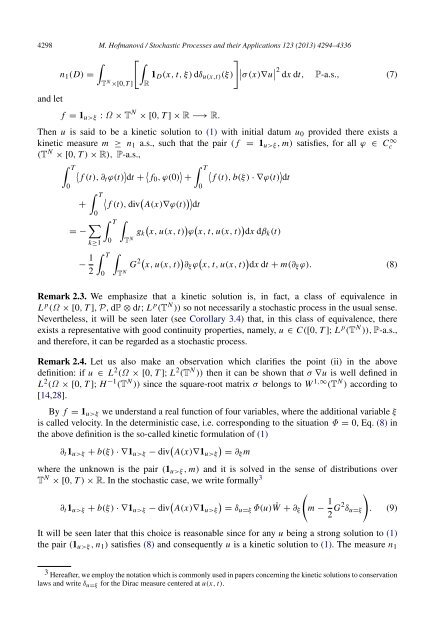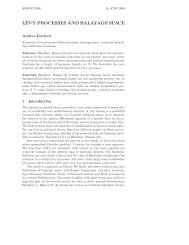Degenerate parabolic stochastic partial differential equations
Degenerate parabolic stochastic partial differential equations
Degenerate parabolic stochastic partial differential equations
Create successful ePaper yourself
Turn your PDF publications into a flip-book with our unique Google optimized e-Paper software.
4298 M. Hofmanová / Stochastic Processes and their Applications 123 (2013) 4294–4336<br />
and let<br />
σ <br />
n 1 (D) =<br />
1 D (x, t, ξ) dδ u(x,t) (ξ)<br />
(x)∇u 2 dx dt, P-a.s., (7)<br />
T N ×[0,T ]<br />
R<br />
f = 1 u>ξ : Ω × T N × [0, T ] × R −→ R.<br />
Then u is said to be a kinetic solution to (1) with initial datum u 0 provided there exists a<br />
kinetic measure m ≥ n 1 a.s., such that the pair ( f = 1 u>ξ , m) satisfies, for all ϕ ∈ Cc<br />
∞<br />
(T N × [0, T ) × R), P-a.s.,<br />
T<br />
0<br />
<br />
f (t), ∂t ϕ(t) dt + f 0 , ϕ(0) T <br />
+ f (t), b(ξ) · ∇ϕ(t) dt<br />
+<br />
T<br />
0<br />
= − k≥1<br />
− 1 2<br />
T<br />
0<br />
<br />
f (t), div<br />
<br />
A(x)∇ϕ(t)<br />
<br />
dt<br />
T<br />
0<br />
<br />
<br />
0<br />
T N g k<br />
<br />
x, u(x, t)<br />
<br />
ϕ<br />
<br />
x, t, u(x, t)<br />
<br />
dx dβk (t)<br />
T N G 2 x, u(x, t) ∂ ξ ϕ x, t, u(x, t) dx dt + m(∂ ξ ϕ). (8)<br />
Remark 2.3. We emphasize that a kinetic solution is, in fact, a class of equivalence in<br />
L p (Ω × [0, T ], P, dP ⊗ dt; L p (T N )) so not necessarily a <strong>stochastic</strong> process in the usual sense.<br />
Nevertheless, it will be seen later (see Corollary 3.4) that, in this class of equivalence, there<br />
exists a representative with good continuity properties, namely, u ∈ C([0, T ]; L p (T N )), P-a.s.,<br />
and therefore, it can be regarded as a <strong>stochastic</strong> process.<br />
Remark 2.4. Let us also make an observation which clarifies the point (ii) in the above<br />
definition: if u ∈ L 2 (Ω × [0, T ]; L 2 (T N )) then it can be shown that σ ∇u is well defined in<br />
L 2 (Ω × [0, T ]; H −1 (T N )) since the square-root matrix σ belongs to W 1,∞ (T N ) according to<br />
[14,28].<br />
By f = 1 u>ξ we understand a real function of four variables, where the additional variable ξ<br />
is called velocity. In the deterministic case, i.e. corresponding to the situation Φ = 0, Eq. (8) in<br />
the above definition is the so-called kinetic formulation of (1)<br />
∂ t 1 u>ξ + b(ξ) · ∇1 u>ξ − div A(x)∇1 u>ξ<br />
<br />
= ∂ξ m<br />
where the unknown is the pair (1 u>ξ , m) and it is solved in the sense of distributions over<br />
T N × [0, T ) × R. In the <strong>stochastic</strong> case, we write formally 3<br />
∂ t 1 u>ξ + b(ξ) · ∇1 u>ξ − div A(x)∇1 u>ξ<br />
<br />
= δu=ξ Φ(u)Ẇ + ∂ ξ<br />
<br />
m − 1 2 G2 δ u=ξ<br />
. (9)<br />
It will be seen later that this choice is reasonable since for any u being a strong solution to (1)<br />
the pair (1 u>ξ , n 1 ) satisfies (8) and consequently u is a kinetic solution to (1). The measure n 1<br />
3 Hereafter, we employ the notation which is commonly used in papers concerning the kinetic solutions to conservation<br />
laws and write δ u=ξ for the Dirac measure centered at u(x, t).



